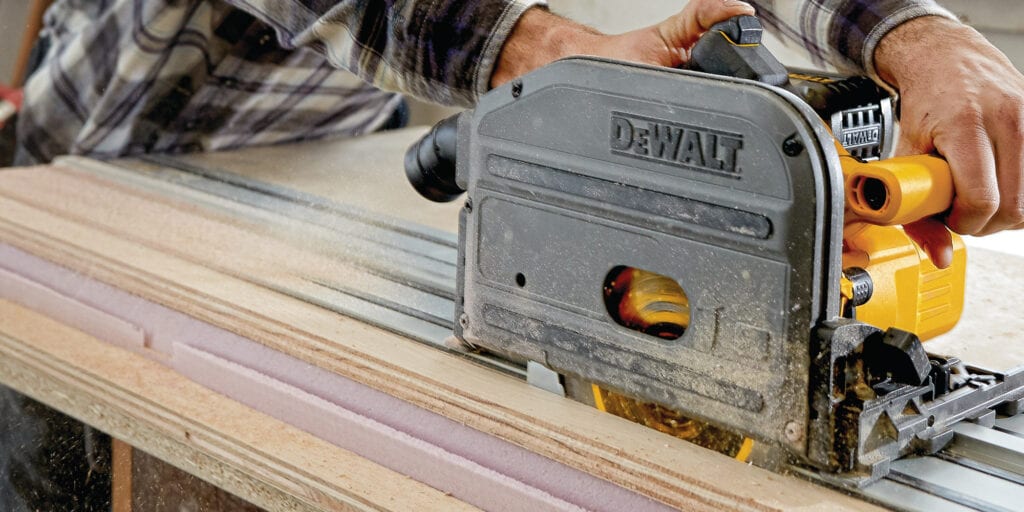
What are Track Saws?
Track saws are specialty tools that serve a very specific purpose in the shop. They are similar to circular saws in that they are handheld circular cutting saws and they are relatively portable. Like circular saws, they are brought to the workpiece rather than the workpiece being brought to the tool.
How are Track Saws Different from Circular Saws?
Track saws differ from circular saws in that they are designed to run along a track system that keeps the saw on a straight path. The saw usually includes grooves in the footplate that mate with matching ridges in the track, so track saws are particularly stable. They aren’t prone to wandering like a circular saw can be since they’re more or less locked into the track.
Unlike circular saws, track saws are designed to be used with their tracks. They can be used off their tracks but that really nullifies their defining feature.
Track saws are also expensive. The most common saws cost over $400. Conversely, the market is replete with economical options for circular saws under $200 (many are even cheaper at sub-$100 price tags!). Ultimately, the decision will boil down to economics: can you justify the extra cost of a track saw and its convenience factor?
What's the Number One Reason You'd Need a Track Saw?
Breaking down sheet goods with finish-quality cuts and repeated accuracy is the primary reason track saws are popular in workshops. Laying down a cut line is a no-brainer and doesn’t require any sort of clamps.
Can a Circular Saw Do the Same Thing?
Absolutely. There isn’t anything a track saw can do that a circular saw cannot also do. It’s a function of speed, accuracy, repeatability, and convenience.
Circular saws can rip long sheets in half but they require a few more steps. Straight edges must be clamped down whereas track saws incorporate rubberized material on the underside of their tracks to provide grip and stability.
Additionally, circular saw blades will be offset against any straight edge used, so that offset must be measured and accounted for. A straight edge can’t be placed right on the cut line. Conversely, track saws can be placed directly on the cut line without any additional measuring and offsetting.
Which Tool Can Make Longer Cuts?
Both circular saws and track saws can perform infinitely long cuts. The limiting factor will be straight edge length for circular saws and track length for track saws. While most track saws come with around five feet of track, additional lengths can be purchased and added to the system. Obviously those extra tracks will cost a bit more than finding a longer straight edge for a circular saw.
So You Want a Track Saw?
Which is the Best?
Check out our in-depth review of a couple of the most popular track saws on the market. If you just want the answer, we like this cordless track saw from DEWALT. It’s super-portable with the cordless power source and the extra safety features are much appreciated.
What are the Best Track Saw Alternatives?
If you decide that you don’t want to drop the extra coin on a specialty item like a track saw, you have plenty of options. You’ll need to build your own package with a circular saw, a straight edge, and clamps. Usually, any combo you build will still come out cheaper than a track saw system.
Start with a circular saw. There are tons of options and we go through a few in this post. Keep in mind that cordless circular saws will do a better job with longer cuts since you won’t have to keep cord snags at bay. Cordless saws keep your focus on the work at hand.
The next step will be to choose a straight edge or guide. Again, there are a few options here.
The cheapest is a 6′ piece of dimensional lumber. 2x4s of most lengths are under $10 at the big box stores so this is by far the most economical option. However, you’ll have to do some digging through the lumber pile to select a straight edge that’s actually straight. Even if you manage to pick out a perfectly straight 2×4, chances are slim that it stays straight with seasonal changes.
You’d be better served investing in a quality straight edge constructed from metal. The lowest priced straight edges are simple spans of metal that are designed specifically for circular saws. Swanson makes a very affordable guide that includes 100-inches (over 8′) of capacity. This particular guide also includes clamps to secure the guide to the workpiece.
If you decide on a different edge guide that doesn’t include clamps, we highly recommend a pair of quick grip clamps. They can be loosened and tightened with one hand and they make quick work of securing a straight edge to your workpiece.
For a little more money, edge guides with integrated clamps make the process a little faster. This edge guide from Bora reaches 50″ and can be lengthed with additional extensions.
Finally, systems like the Accu-Cut guide from Kreg do a fantastic job of replicating the functionality of a track saw. They are the priciest edge guides but they lock the saw into the guide and can be placed directly on the cut lines. Just like a track saw. The Accu-Cut system is our favorite at WWC.
The only thing to consider with this type of system is that we recommend having a dedicated circular saw with the included Kreg base plate installed. Standard circular saws are pretty affordable so it won’t break the bank to have a circular saw specifically designated as the ‘track saw’.
Final Thoughts: Track Saw vs Circular Saw
If you need production-paced processing capacity and your budget allows, a track saw is a fantastic investment for your shop. The accuracy and speed by which large sheet goods can be broken down is unmatched.
If your budget is a bit more constrained and you need to process the occassional 4×8 sheet of plywood or MDF, a straight edge + circular saw combo will fit your bill. Even better, a system that closely replicates a track saw’s capabilities like the Kreg Accu-Cut will serve you well since it occupies the middle ground between a track saw and a simple straight edge.





